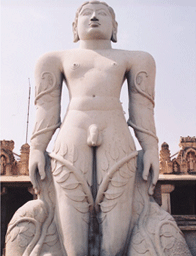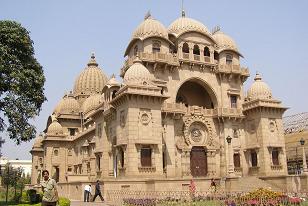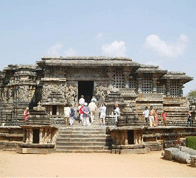|
|
|
Karnataka
Cities |
|
Hassan |
|
Hassan is a picturesque town situated at a distance of 194 kms from Bangalore in Karnataka. Hassan was the oldest town of Hoysala Empire from 11th to 13th century AD in India. The Hoysalas brought world wide acclaim to the district through their unique style of architecture. Recently, Hassan has become a famous tourist destination as it is located near Belur, Halebid and Sravanabelagola. The tourists stay at this quiet and peaceful town to visit Sravanabelagola, Belur and Halebid which are famous for their unique temple architecture. It is well connected by road and rail to Bangalore, Mysore and Mangalore.
|
|
|
|
Sravanabelagola |
 |
Sravanabelagola is situated about 100 km. north of Mysore and 160 kms. from Bangalore. Sravanabelagola is the oldest Jain pilgrimage shrine in South India. Sravanabelagola is mainly known for the colossal statue of Gomateshwara, the Jain Saint, situated on the Landragiri hill. The monolithic image of Gomateshwara is about 57 feet tall and was built by a Ganga king about 1000 years ago. This statue is considered to be the largest monolithic statue in the world. This place has been visited by million of pilgrims every year. The nakedness of the statue tells about the renunciation of all the wordy goods and the stiff posture indicates the perfect self-control. It is also believed that Chandragupta, the Mauryan king visited this place in the 3rd century BC, after renouncing the world. There are also several small Jain statues in the vicinity of this temple. A bathing festival is held here in every 12 years, where the Jain pilgrims from all parts of the world gather here to bathe the statue. During the festival, a special scaffolding is erected to bathe the statue with pots of milk, honey and fruit.
|
|
|
|
Belur |
|
Belur is only 50 km. away from Hassan and 222 kms. from Bangalore. It was a flourishing city about 800 years ago under the Hoysala kings. The Hoysala kings built the temples at
Belur. The Hoysala temples can be compared with the temples at Khajuraho and
Konark. These temple can also rival the Goethic art found anywhere in Europe. Of the three major temples in
Belur, the Channakesava temple today, stands almost as perfectly when it was built and is a tribute to the great builders of the
Hoysala. The Muslim invaders did not destroyed the temple. The Belur temples are also star-shaped like the Somnathpur temple and famous for their exquisite carvings. The temple is squat, flat on the top and set on a platform. It does not have a spire. On the walls of the temple, the
|
 |
|
intricate sculptures of gods and goddesses in their various incarnations and sages and events from the Ramayana and Mahabharata are depicted. The hunting scenes, war scenes, agricultural activities, stylish animals and birds and sensual scenes like the beautiful temple girls in various poses, and decorating themselves are also displayed on the walls. No outer wall or interior without intricate sculptures and no two sculptures have been
repeated. |
|
|
|
|
Somnathpur |
|
Somnathpur temple is situated about 45 km. from Mysore. This temple was built in the 1260 AD during the rule of the Hoysala kings. This temple is considered to be one of the most beautiful and interesting buildings in the world. The walls of the star-shaped temple are literally covered with sculptures in stone that depict the various events in the epics of Ramayana and Mahabharata. No two friezes are alike.
|
|
|
|
Halebid |
 |
Halebid is situated about 16 km. from Belur and 216 kms from Bangalore. The Hoysaleswara Temple at Helebid was built by the Hoysala kings, but remained incomplete in spite of 108 years of
labour. This temple was the finest example of the Hoysala style of temple architecture. This temple is known for its exuberant sculpture and fine workmanship. Here, the virtuosity of Hoysala artists reached its peak. The carvings on the temple was very rich and these artists treated the stone like wood or ivory. The stones they worked on were soft but hardened over the centuries when exposed to rain and sun. The friezes are breathtaking and consists of a row of elephants, lion, swift horses and scenes from the epics. The
Apsaras, the heavenly maidens clothed |
|
in jewels with bracelets on each arm and sitting or standing in graceful poses are also displayed on the walls. The young damsels are about 800 years old but look as fresh as ever. There are about 280 figures that are mostly feminine and can rival the Goethic art. |
|
|
|
|
Aihole |
|
Aihole was once the capital of the early Chalukyan dynasty. Aihole is a picturesque village situated on the banks of the Malaprabha river. There are about 125 temples in Aihole that are divided into 22 groups and scattered all over the village and the fields. About 30 temples in a single enclosure are surrounded by the walls. Most of the temples were built between the sixth and eighth centuries and represent early Hindu temple architecture. Various temples are being excavated here that reflects about the vigorous experimentation done in temple architecture about fourteen centuries ago under the Chalukyas. Aihole is the cradle of the stone temple |
 |
|
architecture of the southern Dravidian school. The Durga Temple in Aihole derives its name from Durgadagudi that means the temple near the fort. This temple is dedicated to Lord Vishnu. This temple is the largest and most elaborately decorated monument, known for its apsidal ended plan and sculptures. The temple stands on a high platform, and columns at the entrance and within the porch are carved with figures and ornamental reliefs. The Ladh Khan Temple was the abode of a Muslim prince, Ladh Khan. It is one of the earliest temples and belongs to the 5th century. One has to climb through the roof on a stone ladder, to come upon a shrine bearing ‘Vishnu’ and ‘Surya' on its walls. From here, you get a panoramic view of the village bordering on the temples. The Meguti Temple is the only dated monument in Aihole. This temple was constructed on the top of a small hill in 634 AD. The temple was built of 630 small stone blocks, and one of the last of its kind in Aihole. This temple is partly in ruins and provides important evidence about the development of the South Indian temple style. |
|
|
|
|
Pattadakal |
|
Pattadakal is a very small village situated on the banks of the Malaprabha river. In the first century AD, the Ptolemy also referred it as the
Pterigal. It was the commemorative site for the Chalukyan kings from the 17th to the 19th centuries. In
Pattadakal, you will see experiments in architecture, and small-scale models. The queens Lokamahadevi and Trailokyamahadevi brought sculptors from Kanchipuram and created fantasies in stone. Pattadakal is unique in having temple architecture of the northern Nagara and southern Dravida
styles. The temples are delicately chiseled, rich in details and use the pink sandstone that flames
in the sunset. The temples represent the end of the Chalukyan architecture and provides one of the most striking
illustrations in India, of the coexistence of different building styles and art traditions. Pattadakal is unique in having temple architecture of the Northern Nagara and Southern Dravidian styles. The oldest temple is the Sanghameswara Temple built by King Vijayditya (696-733 AD). The Mallikarjuna Temple has pillars that depicts the birth and life of Krishna. The ceiling has panels of Gajalakshmi and Nataraja with
Parvati. There are also sculptures of Mahishasura Mardhini and
Ugranarasimha. The Virupaksha is the largest of the temples and has beautiful sculptures and panels depicting scenes from the Ramayana and
Mahabharata. The Papanatha Temple is very unique temple. This temple is built in the northern style, and has impressive carvings on pillars and ceiling, illustrating the episodes from two great Indian epics.
|
|
|
|
Srirangapatnam |
|
The word Srirangapatnam means the city of Sri-Ranga, who is the main deity of this temple town. This town is an island in the
Kaveri river and was the old capital of the ruler Tipu Sultan, known as the Tiger of Mysore. The town is full of forts, palaces and ruins, that stands as testimony to the Tipu Sultan in the 18th century. Due to two lines of fortification separated by water between them and island, Tipu Sultan made Srirangapatnam as his capital, an extremely tough target for the British to fight with. The temple dedicated to Sri Ranga is situated at the heart of this town, whom Tipu used to worship. The long granite statue of Sri Ranga is in reclining posture and part of three such unique temples. The other two similar statues can be seen in Trivandrum and Srirangam in Tamil Nadu.
|
|
|